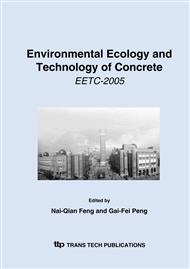p.550
p.556
p.561
p.567
p.572
p.584
p.591
p.595
p.603
Flexural Fatigue Behavior and Performance Characteristics of Polyacrylonitrile Fiber Reinforced Concrete
Abstract:
This paper presents the results of an experimental investigation to determine the flexural fatigue strength and fatigue life of concrete beams reinforced with monofilament polyacrylonitrile fibers (PAN fiber for short). The performance of fresh concrete and the elastic and mechanical properties of hardened concrete are compared by samples with and without fibers. The toughness calculated according to both ASTM and JCI methods increased with the addition of fibers. The toughness indexes I5 was 3.8-4.2 times,I10 was 5.8—6.8 times that of the plain concrete. The equivalent strength was 0.63-0.87 MPa for PAN fiber reinforced concrete. When compared to plain concrete, the endurance limit of concrete beams only reinforced with PAN fiber is increased by 12 percent.
Info:
Periodical:
Pages:
572-583
Citation:
Online since:
January 2006
Authors:
Price:
Сopyright:
© 2006 Trans Tech Publications Ltd. All Rights Reserved
Share:
Citation:


